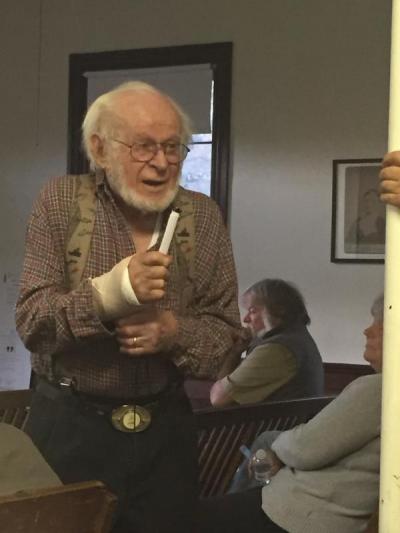Storyteller recounts storms he's lived through
Cukie Macomber is no doubt a gifted storyteller. Despite his tangeants, the crowd hung onto his every word, laughing along the way, at the Dartmouth Historical & Arts Society's May 7 meeting.
Macomber relived the six New England storms that he had survived, with the only interruptions being follow-up questions, spoken at high volume for the 91 year old.
Here's are Macomber's version of hurricanes and snow storms:
1. 1947 Blizzard
"How many people remember driving around with chains on the rear wheels?" Macomber began.
He explained that the chains were necessary back in the 1930s era, because the town didn't plow right down to the blacktop. But if the chains snapped, the driver's bumper would be beaten to bits, he said.
By the late '40s, Macomber worked in the welding and fabrication business. He built a plow for his truck, and built a route in the area of Hixbridge Road.
At one stop, he was unable to continue, and Macomber recounted how he told the plot owner that he had to leave, although it was at first unclear why.
He drove from Cove Road to the Davoll Store in Russells Mills.
"They put me in a bed, and I slept for 24 hours. A man's body isn't made to work for three days without stopping," revealed Macomber.
2. 1938 Hurricane
Macomber described a yellow sky, which he later found out was dust being thrown about by the 100 mile-per-hour winds.
His brother was coming home from school by bus that day, he recalled. As the driver crossed Hix Bridge, water came up onto the floor, he said, recounting his brother's anecdote. But that was a blessing, said Macomber, because the next day, the bridge was gone.
"The driver didn't know if the bridge was there or not," Macomber said.
More than 60 people died at Horseneck Beach alone, the storyteller said.
3. 1954 Hurricane
It was August, and Macomber had gone to the water with his father and some others to fill the floats of his sea plane with water, to keep it from taking off in the high winds.
But as the crew readied to leave, they realized the road was blocked by water. It was impassable, said Macomber.
The group moved their cars up into the dunes. Macomber later found he hadn't moved his high enough. Water had leaked into the body, and began eroding the floor.
"The floor actually fell right out one day when my wife was driving," recalled Macomber.
He said that storm damaged his plane. While the water hadn't gotten into the engine, the salt water would forever be working on the plane's steel framework, he said.
"That was the first hurricane that I actually survived," said Macomber. He noted that he had left the house that day at 5:30 a.m., and that his wife had been worried because there was no way of communicating.
4. Line storm
"Out of the northwest, there was this big, black, black — I mean super black — line, right across the horizon," said Macomber. "You could see it tearing trees up across the river."
The line storm disappeared within 15 minutes, said Macomber. Nothing of his was damaged, but he said a few boats needed repair afterward.
5. 1978 Blizzard
Macomber worked for the Prelude Company at the time of the Blizzard of '78, and driving to work in a company car, he faced several road blockages.
"There had to be 150 cars all the way to Providence, and not one of them was moving," recalled Macomber.
He tried several times to switch routes, and eventually landed at a convenience store, where he began to settle in with numerous others. A state trooper came in, and ordered everyone to get on a bus that was stuck in the snow. Macomber laughed, sure there was no way that the bus would be dislodged, or that it could pass the buildup along the roads.
But the state had a weapon.
"It was the biggest bucket loader I'd ever seen," recalled Macomber. The loader pucker the bus out of the snow, and then began clearing the road. A Volkswagen bug fit right in the bucket, said Macomber.
The crowd was transported to a church in Wickford, Rhode Island, where they spent the next three days. Supplies were transported in for the temporary residents.
"What those groceries was American chop suey and spaghetti. We had it three times a day," laughed Macomber.
One of the church's neighbors gave his television to the 125-person crowd, easing their stay, said Macomber. The surrounding roads were finally cleared by two bulldozers, rolling the cars out of the road, he said.
"The governor wanted Kent County Hospital opened no matter the cost," said Macomber. He said wreckers took a week to clear I-95, and pulled the cars out one at a time.
6. 1944 Hurricane
Macomber worked for the Coast Guard reserve in the '40s, and the crew was ordered to assist fishermen who had gotten stuck in the storm. Around 2 a.m., two flares went off in he southeast, recounted Macomber.
The winds were blowing over 200 miles per hour, and they were unable to immediately asssit, he explained.
The next morning, the crew went looking for a probably sunken Vineyard Sound Light Ship.
"It went down with all the crew. No one was saved," Macomber later found out. A fellow boater had tipped off the reserve team to a sunken ship. Macomber's diver friend went under, and the photos he took revealed that the spare anchor had gone through the side of the boat, he said.













